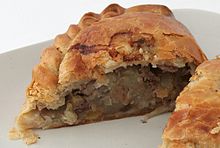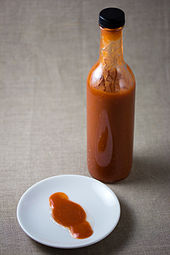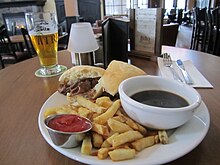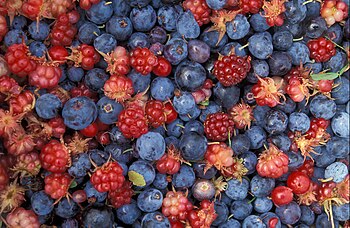F o o d
A portal dedicated to food and foodways
Introduction


Food is any substance consumed by an organism for nutritional support. Food is usually of plant, animal, or fungal origin and contains essential nutrients such as carbohydrates, fats, proteins, vitamins, or minerals. The substance is ingested by an organism and assimilated by the organism's cells to provide energy, maintain life, or stimulate growth. Different species of animals have different feeding behaviours that satisfy the needs of their metabolisms and have evolved to fill a specific ecological niche within specific geographical contexts.
Omnivorous humans are highly adaptable and have adapted to obtain food in many different ecosystems. Humans generally use cooking to prepare food for consumption. The majority of the food energy required is supplied by the industrial food industry, which produces food through intensive agriculture and distributes it through complex food processing and food distribution systems. This system of conventional agriculture relies heavily on fossil fuels, which means that the food and agricultural systems are one of the major contributors to climate change, accounting for as much as 37% of total greenhouse gas emissions. (Full article...)
Cooking, also known as cookery or professionally as the culinary arts, is the art, science and craft of using heat to make food more palatable, digestible, nutritious, or safe. Cooking techniques and ingredients vary widely, from grilling food over an open fire, to using electric stoves, to baking in various types of ovens, reflecting local conditions. Cooking is an aspect of all human societies and a cultural universal.
Preparing food with heat or fire is an activity unique to humans. Archeological evidence of cooking fires from at least 300,000 years ago exists, but some estimate that humans started cooking up to 2 million years ago.
The expansion of agriculture, commerce, trade, and transportation between civilizations in different regions offered cooks many new ingredients. New inventions and technologies, such as the invention of pottery for holding and boiling of water, expanded cooking techniques. Some modern cooks apply advanced scientific techniques to food preparation to further enhance the flavor of the dish served. (Full article...)
Food waste in the United Kingdom is a subject of environmental, and socioeconomic concern that has received widespread media coverage and been met with varying responses from government. Since 1915, food waste has been identified as a considerable problem and has been the subject of ongoing media attention, intensifying with the launch of the "Love Food, Hate Waste" campaign in 2007. Food waste has been discussed in newspaper articles, news reports and television programmes, which have increased awareness of it as a public issue. To tackle waste issues, encompassing food waste, the government-funded "Waste & Resources Action Programme" (WRAP) was created in 2000.
A significant proportion of food waste is produced by the domestic household, which in 2007[needs update] created 6,700,000 tonnes of food waste. Potatoes, bread slices and apples are the most wasted foods by quantity, while salads are thrown away in the greatest proportion. A majority of food waste food is avoidable,[d] with the rest being divided almost equally into foods which are unavoidable (e.g. tea bags) and those that are unavoidable due to preference (e.g. bread crusts) or cooking type (e.g. potato skins). (Full article...)
Selected article –
Sushi (すし, 寿司, 鮨, 鮓, pronounced [sɯɕiꜜ] or [sɯꜜɕi] ) is a Japanese dish of prepared vinegared rice (鮨飯, sushi-meshi), usually with some sugar and salt, plus a variety of ingredients (ねた, neta), such as vegetables, and any meat, but most commonly seafood (often raw but can be cooked). Styles of sushi and its presentation vary widely, but the one key ingredient is "sushi rice", also referred to as shari (しゃり), or sumeshi (酢飯).
The creator of modern sushi is believed to be Hanaya Yohei, who invented nigiri-zushi, a type of sushi most known today, in which seafood is placed on hand-pressed vinegared rice, around 1824 in the Edo period (1603–1867). It was the fast food of the chōnin class in the Edo period. (Full article...)Selected cuisine -

Cornish cuisine encompasses the cooking styles, traditions and recipes associated with Cornwall and the Cornish people. It has been heavily influenced by the geography of the county as well as its social history.
Cornwall, being a peninsula surrounded by seas historically well-stocked with fish, has meant that fish dishes form a major part of the historical and modern recipes in Cornwall. The fishing industry has played a major part in the economy of the county. The iconic dish of Cornwall, the pasty, has its roots in another historical industry within the county, this being mining. (Full article...)Selected ingredient –

Hot sauce is a type of condiment, seasoning, or salsa made from chili peppers and other ingredients. Many commercial varieties of mass-produced hot sauce exist. (Full article...)
Selected recipe –
A French dip sandwich, also known as a beef dip, is a hot sandwich consisting of thinly sliced roast beef (or, sometimes, other meats) on a "French roll" or baguette. It is usually served plain but a popular variation is to top with Swiss cheese, onions, and a dipping container of beef broth produced from the cooking process (termed au jus, "with juice"). Beef stock, a light beef gravy, or beef consommé is sometimes substituted. The sandwich is an American invention, with the name seeming to refer to the style of bread, rather than any French origin. Although the sandwich is most commonly served with a cup of jus or broth on the side of the plate, into which the sandwich is dipped as it is eaten, this is not how the sandwich was served when it was originally developed. (Full article...)
Boletus edulis (English: cep, penny bun, porcino or porcini) is a basidiomycete fungus, and the type species of the genus Boletus. Widely distributed in the Northern Hemisphere across Europe, Asia, and North America, it does not occur naturally in the Southern Hemisphere, although it has been introduced to southern Africa, Australia, New Zealand, and Brazil. Several closely related European mushrooms formerly thought to be varieties or forms of B. edulis have been shown using molecular phylogenetic analysis to be distinct species, and others previously classed as separate species are conspecific with this species. The western North American species commonly known as the California king bolete (Boletus edulis var. grandedulis) is a large, darker-coloured variant first formally identified in 2007.
The fungus grows in deciduous and coniferous forests and tree plantations, forming symbiotic ectomycorrhizal associations with living trees by enveloping the tree's underground roots with sheaths of fungal tissue. The fungus produces spore-bearing fruit bodies above ground in summer and autumn. The fruit body has a large brown cap which on occasion can reach 30 cm (12 in), rarely 40 cm (16 in) in diameter and 3 kg (6 lb 10 oz) in weight. Like other boletes, it has tubes extending downward from the underside of the cap, rather than gills; spores escape at maturity through the tube openings, or pores. The pore surface of the B. edulis fruit body is whitish when young, but ages to a greenish-yellow. The stout stipe, or stem, is white or yellowish in colour, up to 20 cm (8 in), rarely 30 cm (12 in) tall and 10 cm (4 in) thick, and partially covered with a raised network pattern, or reticulations. (Full article...)Selected image –
Selected biography –
B. September 13, 1857 – d. October 13, 1945
Milton Snavely Hershey (September 13, 1857 – October 13, 1945) was an American chocolatier, businessman, and philanthropist.
Trained in the confectionery business, Hershey pioneered the manufacture of caramel, using fresh milk. He launched the Lancaster Caramel Company, which achieved bulk exports, and then sold it to start a new company supplying mass-produced milk chocolate, previously a luxury good. (Full article...)
Did you know (auto-generated) –

- ... that in 1969, the man from Del Monte said yes to Eldorado Electrodata?
- ... that staff at the vegan food brand VFC interact with internet trolls on social media platforms to grow their online brand?
- ... that before Angeli Foods was sold this year, the first self-service grocery store in the Upper Peninsula of Michigan had been owned by three generations of a single family?
- ... that Raymond Bushland and Edward F. Knipling won the 1992 World Food Prize for developing the sterile insect technique which eliminated parasitic screw-worms from the United States?
- ... that in times of food scarcity, the collared sand anemone may consume the symbiotic zooxanthellae in its tissues?
- ... that Binggrae, a South Korean food and beverage company, was the official ice cream supplier of the 1988 Seoul Olympics?
More did you know –
Related portals
Food topics
The following are topics relating to food
Categories
Food list articles
- See also: Lists of foods and Category:Lists of drinks
The following are some Food list articles on Wikipedia:

- American cheeses
- Appellation d'Origine Contrôlée cheeses
- Apple cultivars
- Bacon dishes
- Bacon substitutes
- Basil cultivars
- Breads
- Breakfast beverages
- Breakfast cereals
- Breakfast foods
- British cheeses
- Cakes
- Candies
- Cheeses
- Cheese soups
- Christmas dishes (list)
- Cocktails
- Cookies
- Dishes using coconut milk
- Diets
- Doughnut varieties
- Egg dishes
- Fermented soy products
- Food additives
- Food additives (Codex Alimentarius)
- Foods named after people
- French cheeses
- French dishes
- Fried dough foods
- Fruits
- List of hamburgers
- Herbs and spices
- Hors d'oeuvre
- Indian dishes
- Indian snack foods
- Indonesian dishes
- Italian dishes
- Japanese snacks
- Japanese dishes
- Jewish dishes
- Kebabs
- Korean beverages
- Mango cultivars
- Moroccan dishes
- Pasta
- Pastries
- Philippine snack food
- Pies, tarts and flans
- Poppy seed pastries and dishes
- Potato dishes
- Puddings
- Raw fish dishes
- Rice dishes
- Rolled foods
- Sauces
- Seafood
- Seeds
- Sandwiches
- Snack foods
- Soft drinks by country
- Soul foods and dishes
- Soups
- Stews
- Street foods
- Tapas
- Turkish dishes
- Twice-baked foods
- Vegetable oils
- Vegetables
- Vodkas
Things you can do
Related WikiProjects
| Parent project: WikiProject Food and Drink | |
| Child projects: | Task forces: (All inactive) |
|
|
| Related projects: | |
New articles
Rules | Match log | Results page (for watching) | Last updated: 2024-05-26 19:20 (UTC)
Note: The list display can now be customized by each user. See List display personalization for details.
- Torta Balcarce ( | talk | history | links | watch | logs | tools) by Murmuring Rock (talk · contribs · new pages (2)) started on 2024-05-25, score: 20
- Bilal Yalcinkaya ( | talk | history | links | watch | logs | tools) by Das osmnezz (talk · contribs · new pages (65)) started on 2024-05-23, score: 10
- Andok's ( | talk | history | links | watch | logs | tools) by Karich28 (talk · contribs · new pages (10)) started on 2024-05-22, score: 20
- Doe Donuts ( | talk | history | links | watch | logs | tools) by Another Believer (talk · contribs · new pages (133)) started on 2024-05-23, score: 10
- I, the Executioner (2024 film) ( | talk | history | links | watch | logs | tools) by Οἶδα (talk · contribs · new pages (32)) started on 2024-05-21, score: 10
- Virginia Sole-Smith ( | talk | history | links | watch | logs | tools) by Marquardtika (talk · contribs · new pages (1)) started on 2024-05-22, score: 10
- Lohusa şerbeti ( | talk | history | links | watch | logs | tools) by Macrakis (talk · contribs · new pages (6)) started on 2024-05-22, score: 30
- I, the Executioner ( | talk | history | links | watch | logs | tools) by Οἶδα (talk · contribs · new pages (32)) started on 2024-05-21, score: 10
- Paul Parkman ( | talk | history | links | watch | logs | tools) by Thriley (talk · contribs · new pages (52)) started on 2024-05-21, score: 10
- Two Roosters Ice Cream ( | talk | history | links | watch | logs | tools) by Johnson524 (talk · contribs · new pages (4)) started on 2024-05-21, score: 10
- There Be Monsters ( | talk | history | links | watch | logs | tools) by Another Believer (talk · contribs · new pages (133)) started on 2024-05-21, score: 10
- Chinir saaj ( | talk | history | links | watch | logs | tools) by Moriwen (talk · contribs · new pages (140)) started on 2024-05-21, score: 30
- Doogh ( | talk | history | links | watch | logs | tools) by MuhammedBenShalom (talk · contribs · new pages (1)) started on 2024-05-21, score: 20
- Sata physic gardens ( | talk | history | links | watch | logs | tools) by MChew (talk · contribs · new pages (12)) started on 2024-05-21, score: 10
- Nam Dae-sik ( | talk | history | links | watch | logs | tools) by Das osmnezz (talk · contribs · new pages (65)) started on 2024-05-20, score: 10
- Le Chique ( | talk | history | links | watch | logs | tools) by Another Believer (talk · contribs · new pages (133)) started on 2024-05-20, score: 10
- Khanom met khanun ( | talk | history | links | watch | logs | tools) by Quantplinus (talk · contribs · new pages (1)) started on 2024-05-18, score: 10
- Pao Alentejano ( | talk | history | links | watch | logs | tools) by Valereee (talk · contribs · new pages (11)) started on 2024-05-20, score: 10
- Sir Grapefellow and Baron von Redberry ( | talk | history | links | watch | logs | tools) by Retrosunshine2006 (talk · contribs · new pages (1)) started on 2024-05-20, score: 20
- Pharasmanes II ( | talk | history | links | watch | logs | tools) by BilledMammal (talk · contribs · new pages (182)) started on 2024-05-19, score: 10
- Kinamatisang manok ( | talk | history | links | watch | logs | tools) by Obsidian Soul (talk · contribs · new pages (7)) started on 2024-05-19, score: 10
- Federal Food, Drug, and Cosmetic Act of 1938 ( | talk | history | links | watch | logs | tools) by Irruptive Creditor (talk · contribs · new pages (1)) started on 2024-05-19, score: 10
- IT'SUGAR ( | talk | history | links | watch | logs | tools) by AbsentPat (talk · contribs · new pages (4)) started on 2024-05-19, score: 20
- Harvey's Butter Rum Batter ( | talk | history | links | watch | logs | tools) by AbsentPat (talk · contribs · new pages (4)) started on 2024-05-19, score: 20
- Mar-Jac Poultry ( | talk | history | links | watch | logs | tools) by TJMSmith (talk · contribs · new pages (16)) started on 2024-05-18, score: 10
- Festival del Sole ( | talk | history | links | watch | logs | tools) by 87.74.175.29 (talk · contribs · new pages (2)) started on 2024-05-18, score: 20
- Chew: International Flavor ( | talk | history | links | watch | logs | tools) by IzzyBell Oskverry (talk · contribs · new pages (0)) started on 2024-05-07, score: 10
- Joyride Sweets ( | talk | history | links | watch | logs | tools) by Bennett1203 (talk · contribs · new pages (14)) started on 2024-05-18, score: 40
- Khanom Med Khanoon ( | talk | history | links | watch | logs | tools) by Quantplinus (talk · contribs · new pages (1)) started on 2024-05-18, score: 10
- Tony Connor (musician) ( | talk | history | links | watch | logs | tools) by Anavatar (talk · contribs · new pages (7)) started on 2024-05-18, score: 10
- Patrick Olive ( | talk | history | links | watch | logs | tools) by Anavatar (talk · contribs · new pages (7)) started on 2024-05-18, score: 10
- Taquería El Califa de León ( | talk | history | links | watch | logs | tools) by Tbhotch (talk · contribs · new pages (31)) started on 2024-05-18, score: 10
- Harvey Hinsley ( | talk | history | links | watch | logs | tools) by Anavatar (talk · contribs · new pages (7)) started on 2024-05-17, score: 10
- Fulcrum Coffee ( | talk | history | links | watch | logs | tools) by Another Believer (talk · contribs · new pages (133)) started on 2024-05-17, score: 10
- Kutach ( | talk | history | links | watch | logs | tools) by PiMaster3 (talk · contribs · new pages (3)) started on 2024-05-16, score: 20
- White Rhino Coffee ( | talk | history | links | watch | logs | tools) by Blizzleduh (talk · contribs · new pages (1)) started on 2024-05-15, score: 10
- On2Cook ( | talk | history | links | watch | logs | tools) by Roadrazer84 (talk · contribs · new pages (1)) started on 2024-05-15, score: 10
- MDH and Everest global safety concerns ( | talk | history | links | watch | logs | tools) by Sherenk1 (talk · contribs · new pages (1)) started on 2024-05-15, score: 20
- Domoda ( | talk | history | links | watch | logs | tools) by Monomi0 (talk · contribs · new pages (1)) started on 2024-05-14, score: 10
- Kōji (food) ( | talk | history | links | watch | logs | tools) by Ghilt (talk · contribs · new pages (4)) started on 2024-05-13, score: 10
- Koji (food) ( | talk | history | links | watch | logs | tools) by Ghilt (talk · contribs · new pages (4)) started on 2024-05-13, score: 10
- Half and Half Doughnut Co. ( | talk | history | links | watch | logs | tools) by Another Believer (talk · contribs · new pages (133)) started on 2024-05-13, score: 10
- Williams and Woods ( | talk | history | links | watch | logs | tools) by GeneralBelly (talk · contribs · new pages (3)) started on 2024-05-12, score: 10
- Thamnaconus hypargyreus ( | talk | history | links | watch | logs | tools) by Primium (talk · contribs · new pages (8)) started on 2024-05-12, score: 10
- Akbar Mirza Khaleeli ( | talk | history | links | watch | logs | tools) by Bingchungus (talk · contribs · new pages (2)) started on 2024-05-12, score: 10
- Garry Kennebrew ( | talk | history | links | watch | logs | tools) by AllWeKnowOfHeaven (talk · contribs · new pages (2)) started on 2024-05-06, score: 10
- Demonstration kitchen ( | talk | history | links | watch | logs | tools) by Whoisjohngalt (talk · contribs · new pages (2)) started on 2024-05-12, score: 20
- China in Box ( | talk | history | links | watch | logs | tools) by Vitorperrut555 (talk · contribs · new pages (2)) started on 2024-05-12, score: 20
- Chinatown Ice Cream Factory ( | talk | history | links | watch | logs | tools) by ForsythiaJo (talk · contribs · new pages (98)) started on 2024-05-11, score: 10
- Pepsi AM ( | talk | history | links | watch | logs | tools) by Tatsnorad (talk · contribs · new pages (1)) started on 2024-05-11, score: 20
Associated Wikimedia
The following Wikimedia Foundation sister projects provide more on this subject:
-
 Commons
Commons
Free media repository -
 Wikibooks
Wikibooks
Free textbooks and manuals -
 Wikidata
Wikidata
Free knowledge base -
 Wikinews
Wikinews
Free-content news -
 Wikiquote
Wikiquote
Collection of quotations -
 Wikisource
Wikisource
Free-content library -
 Wikiversity
Wikiversity
Free learning tools -
 Wiktionary
Wiktionary
Dictionary and thesaurus











































Recent Comments